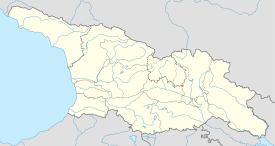Tbilisi Sioni Cathedral
| Cathedral of Saint Mary of Zion სიონის ღვთისმშობლის მიძინების ტაძარი |
|
|---|---|

Sioni Cathedral
|
|
| Basic information | |
| Location | Sionis Kucha, Tbilisi, Georgia |
| Geographic coordinates | 41°41′29″N 44°48′27″E / 41.6914°N 44.8075°ECoordinates: 41°41′29″N 44°48′27″E / 41.6914°N 44.8075°E |
| Affiliation | Georgian Orthodox Church |
| Architectural description | |
| Architectural type | Church |
| Completed | Church: 6th-7th century, renovated 13th century and 17th-18th century. Belfry: 1812 |
| Dome(s) | 1 |
The Sioni Cathedral of the Dormition (Georgian: სიონის ღვთისმშობლის მიძინების ტაძარი) is a Georgian Orthodox cathedral in Tbilisi, the capital of Georgia. Following a medieval Georgian tradition of naming churches after particular places in the Holy Land, the Sioni Cathedral bears the name of Mount Zion at Jerusalem. It is commonly known as the "Tbilisi Sioni" to distinguish it from several other churches across Georgia bearing the name Sioni.
The Tbilisi Sioni Cathedral is situated in historic Sionis Kucha (Sioni Street) in downtown Tbilisi, with its eastern façade fronting the right embankment of the Kura River. It was initially built in the 6th and 7th centuries. Since then, it has been destroyed by foreign invaders and reconstructed several times. The current church is based on a 13th-century version with some changes from the 17th to 19th centuries. The Sioni Cathedral was the main Georgian Orthodox Cathedral and the seat of Catholicos-Patriarch of All Georgia until the Holy Trinity Cathedral was consecrated in 2004.
According to medieval Georgian annals, the construction of the original church on this site was initiated by King Vakhtang Gorgasali in the 5th century. A hundred years later, Guaram, the prince of Iberia (Kartli), in c. 575 began building a new structure, which was completed by his successor Adarnase in circa 639. According to legend, both princes were buried in this church, but no trace of their graves has been found. This early church was completely destroyed by Arabs, and was subsequently built de novo.
...
Wikipedia

